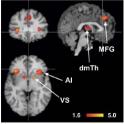THE COGNITIVE STIMULUS OF AMBIGUITY
The Eide Neurolearning Blog, one of my favorite stops in the blogosphere, had an important post for those concerned with creativity, learning and cognition. “Beyond Black & White: Learning to Tolerate Ambiguity “. An excerpt:
“The picture below shows an interesting view into the biology of perceiving ambiguity – when decisions about categories are not so clear. And, it shows that frontal striatal circuits play an important role in recognizing ambiguity.

… In fact, ambiguity is not well-recognized as an important part of nearly all creative processes (some examples below). In brainstorming sessions, innovative work teams may practice with ambiguity exercises like those posted in the bottom link. There’s a book called The First Honest Book About Lies* that we like…at the bottom of the cover it says *You always have to read the asterisk. It has its humorous side, but about ambiguity – it hits the mark. The book starts out with optical illusions (these are ambiguous, aren’t they?), then moves on the topics like white lies and propaganda. In a gentle way, it introduces the idea that real life lived is filled with ambiguity and nuance – and you may find it a valuable starting point for discussion.”
Zen, particularly the practice of meditating upon the meaning of koans, riddles that are constructed paradoxically or seemingly irrationally (” what is the sound of one hand clapping?”) that are meant to be understood not by reasoning, but by insight, relies heavily upon ambiguity as a trigger. Some aspects of Sufi stories or parables also demonstrate this cognitive quality.
My speculation here is that the use of ambiguity prevents the brain from engaging in a kind of autopilot filing process and instead has to try and ” search” among a variety of possible contextual meanings, leading to new connections.